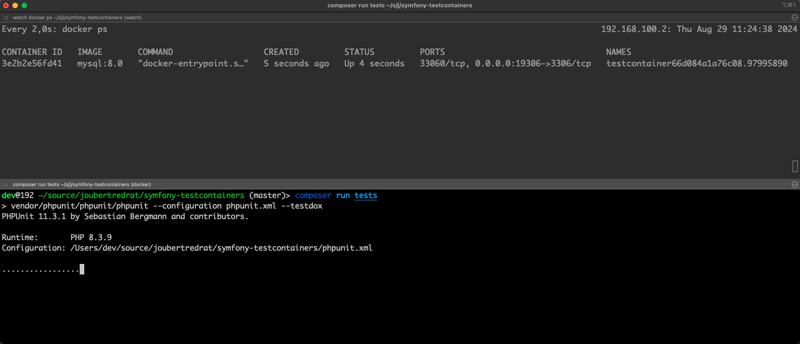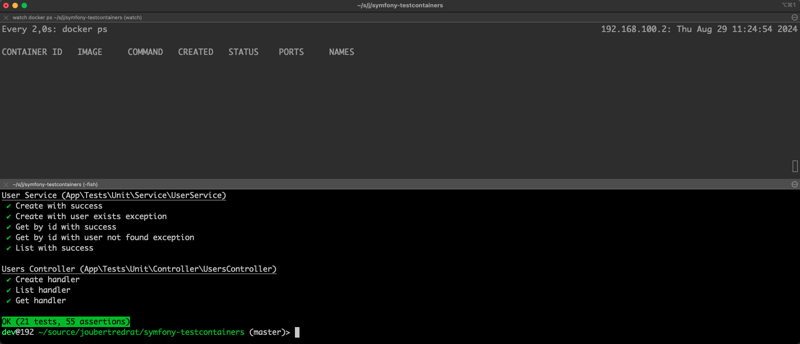Integration tests on Symfony with Testcontainers
Disclaimer: I'm not a divine entity. What I say is not an absolute truth. Don't be afraid to question even the world, because it might be wrong, not you.
Today isn't a secret for nobody the importance of automated tests for keeping quality and integrity of your software and normally we talk much about unit tests, but, today, we will focus more in integration tests into Symfony Framework.
I have no patience, show me the code!
Okay okay! If you have no patience for reading the article, I have a test project with the implementation of this article in link below.
https://github.com/joubertredrat/symfony-testcontainers
Symfony Framework and integration tests
Today Symfony Framework is one of most mature and stable frameworks in PHP universe and it have various good implemented solutions, as integration tests for example. But, personally I always thought that although is easy to do integration tests itself, to provide external dependencies for test It wasn't always so easy, as databases for example.
Even with a solutions like Docker, I still realized necessity to provide the external dependencies in a way for the tests, but, exists a very interesting solution that can make this step much easier, the Testcontainers.
Testcontainers
Testcontainers is an open source framework that let you provide in a easy way any external dependency that you need using Docker, as databases, message broker, cache system, or ever dependency in container.
The big advantages of Testcontainers in relation to Docker compose or other way of container orchestration is you can code the provisioning of container, and today already have support to Golang, Java, .NET, Node.js, Python, Rust, various other languages and of course, PHP too!
My first contact with Testcontainers was in a project in Golang and I liked so much the facility of provisioning MongoDB container to do the repository tests and after that, I decided to do same thing in my personal project in PHP using Symfony Framework.
Symfony Testcontainers = ❤️
One of biggest advantages of Symfony is the support to do tests integrated with PHPUnit and with a functional kernel to do the bootstrap necessary for the tests.
Although Testcontainers have support to PHP, their implementation is recent and you can view it at https://github.com/testcontainers/testcontainers-php.
Below we have a implementation of MySQL 8.0 container, that is a external dependency of this project, and the boot of Symfony kernel, creation of database and schema.
class IntegrationTestCase extends KernelTestCase
{
protected static ?MySQLContainer $container = null;
public static function setUpBeforeClass(): void
{
parent::setUpBeforeClass();
if (!static::$container) {
static::$container = MySQLContainer::make('8.0', 'password');
static::$container->withPort('19306', '3306');
static::$container->run();
$kernel = self::bootKernel();
$container = $kernel->getContainer();
$application = new Application($kernel);
$application->setAutoExit(false);
$application->run(
new ArrayInput(['command' => 'doctrine:database:create', '--if-not-exists' => true])
);
$entityManager = $container->get('doctrine')->getManager();
$metadata = $entityManager->getMetadataFactory()->getAllMetadata();
$schemaTool = new SchemaTool($entityManager);
$schemaTool->dropSchema($metadata);
$schemaTool->createSchema($metadata);
}
}
public static function tearDownAfterClass(): void
{
parent::tearDownAfterClass();
if (static::$container instanceof MySQLContainer) {
static::$container->remove();
}
}
With this, we have the basis class for the classes that will execute the tests itself, as example below.
class UserRepositoryTest extends IntegrationTestCase
{
public function testSave(): void
{
$user = new User();
$user->setName('John Doe');
$user->setEmail('john@doe.local');
$repo = $this->getRepository();
$repo->save($user, true);
self::assertNotNull($user->getId());
self::assertIsInt($user->getId());
self::assertTrue($user->getId() > 0);
}
public function testGetByEmail(): void
{
$user = new User();
$user->setName('John Doe');
$user->setEmail('john2@doe.local');
$repo = $this->getRepository();
$userNotFound = $repo->getByEmail($user->getEmail());
self::assertNull($userNotFound);
$repo->save($user, true);
$userFound = $repo->getByEmail($user->getEmail());
self::assertEquals($user->getEmail(), $userFound->getEmail());
}
protected function tearDown(): void
{
parent::tearDown();
$connection = $this
->getContainer()
->get('doctrine')
->getManager()
->getConnection()
;
$connection->executeStatement('TRUNCATE TABLE users');
}
protected function getRepository(): UserRepository
{
return $this->getContainer()->get(UserRepository::class);
}
}
When running suite of tests, you can view that tests will execute slowly compared with unit tests of tests with just mocked behaviors, but this is normal, because during this process, Testcontainers is provisioning the container that you defined to use in tests.


Finally, with this facility, can be possible to do crazy things, like 100% of coverage. Don't believe it? You can see for yourself at https://joubertredrat.github.io/symfony-testcontainers.
That's it, see you next!
The above is the detailed content of Integration tests on Symfony with Testcontainers. For more information, please follow other related articles on the PHP Chinese website!

Hot AI Tools

Undresser.AI Undress
AI-powered app for creating realistic nude photos

AI Clothes Remover
Online AI tool for removing clothes from photos.

Undress AI Tool
Undress images for free

Clothoff.io
AI clothes remover

Video Face Swap
Swap faces in any video effortlessly with our completely free AI face swap tool!

Hot Article

Hot Tools

Notepad++7.3.1
Easy-to-use and free code editor

SublimeText3 Chinese version
Chinese version, very easy to use

Zend Studio 13.0.1
Powerful PHP integrated development environment

Dreamweaver CS6
Visual web development tools

SublimeText3 Mac version
God-level code editing software (SublimeText3)

Hot Topics
 Alipay PHP SDK transfer error: How to solve the problem of 'Cannot declare class SignData'?
Apr 01, 2025 am 07:21 AM
Alipay PHP SDK transfer error: How to solve the problem of 'Cannot declare class SignData'?
Apr 01, 2025 am 07:21 AM
Alipay PHP...
 Explain JSON Web Tokens (JWT) and their use case in PHP APIs.
Apr 05, 2025 am 12:04 AM
Explain JSON Web Tokens (JWT) and their use case in PHP APIs.
Apr 05, 2025 am 12:04 AM
JWT is an open standard based on JSON, used to securely transmit information between parties, mainly for identity authentication and information exchange. 1. JWT consists of three parts: Header, Payload and Signature. 2. The working principle of JWT includes three steps: generating JWT, verifying JWT and parsing Payload. 3. When using JWT for authentication in PHP, JWT can be generated and verified, and user role and permission information can be included in advanced usage. 4. Common errors include signature verification failure, token expiration, and payload oversized. Debugging skills include using debugging tools and logging. 5. Performance optimization and best practices include using appropriate signature algorithms, setting validity periods reasonably,
 How does session hijacking work and how can you mitigate it in PHP?
Apr 06, 2025 am 12:02 AM
How does session hijacking work and how can you mitigate it in PHP?
Apr 06, 2025 am 12:02 AM
Session hijacking can be achieved through the following steps: 1. Obtain the session ID, 2. Use the session ID, 3. Keep the session active. The methods to prevent session hijacking in PHP include: 1. Use the session_regenerate_id() function to regenerate the session ID, 2. Store session data through the database, 3. Ensure that all session data is transmitted through HTTPS.
 Describe the SOLID principles and how they apply to PHP development.
Apr 03, 2025 am 12:04 AM
Describe the SOLID principles and how they apply to PHP development.
Apr 03, 2025 am 12:04 AM
The application of SOLID principle in PHP development includes: 1. Single responsibility principle (SRP): Each class is responsible for only one function. 2. Open and close principle (OCP): Changes are achieved through extension rather than modification. 3. Lisch's Substitution Principle (LSP): Subclasses can replace base classes without affecting program accuracy. 4. Interface isolation principle (ISP): Use fine-grained interfaces to avoid dependencies and unused methods. 5. Dependency inversion principle (DIP): High and low-level modules rely on abstraction and are implemented through dependency injection.
 How to debug CLI mode in PHPStorm?
Apr 01, 2025 pm 02:57 PM
How to debug CLI mode in PHPStorm?
Apr 01, 2025 pm 02:57 PM
How to debug CLI mode in PHPStorm? When developing with PHPStorm, sometimes we need to debug PHP in command line interface (CLI) mode...
 Framework Security Features: Protecting against vulnerabilities.
Mar 28, 2025 pm 05:11 PM
Framework Security Features: Protecting against vulnerabilities.
Mar 28, 2025 pm 05:11 PM
Article discusses essential security features in frameworks to protect against vulnerabilities, including input validation, authentication, and regular updates.
 How to automatically set permissions of unixsocket after system restart?
Mar 31, 2025 pm 11:54 PM
How to automatically set permissions of unixsocket after system restart?
Mar 31, 2025 pm 11:54 PM
How to automatically set the permissions of unixsocket after the system restarts. Every time the system restarts, we need to execute the following command to modify the permissions of unixsocket: sudo...
 Explain late static binding in PHP (static::).
Apr 03, 2025 am 12:04 AM
Explain late static binding in PHP (static::).
Apr 03, 2025 am 12:04 AM
Static binding (static::) implements late static binding (LSB) in PHP, allowing calling classes to be referenced in static contexts rather than defining classes. 1) The parsing process is performed at runtime, 2) Look up the call class in the inheritance relationship, 3) It may bring performance overhead.






